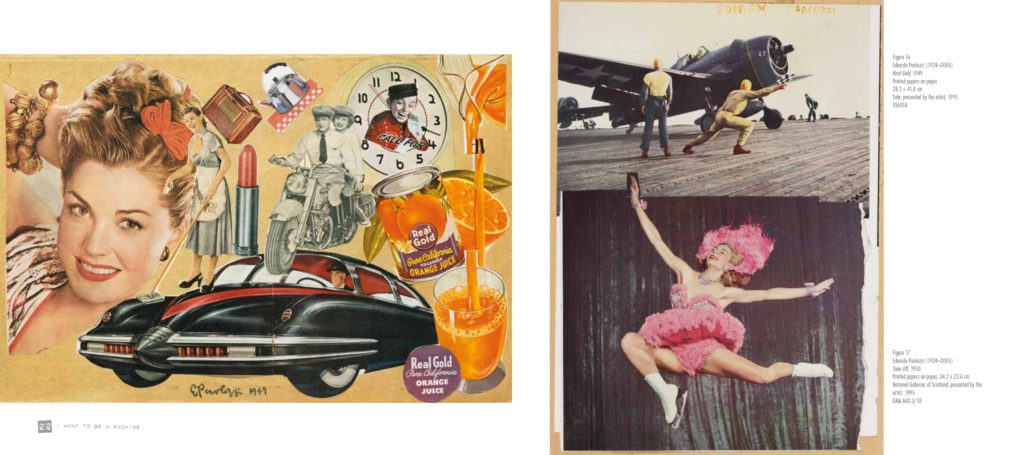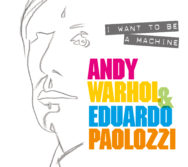‘Paolozzi was a voracious consumer of images and information…’
The parallels between the art of Andy Warhol and Edinburgh-born Eduardo Paolozzi was celebrated by the Scottish Gallery of Modern Art in late 2018, and the accompanying book is full of great insight and images on and from both these iconic artists, and particularly on their early works. Here’s an extract from Keith Hartley, Chief Curator and Deputy Director at the Scottish National Gallery of Modern Art.
Extract taken from I Want to be a Machine: Warhol and Paolozzi
By Keith Hartley
Published by the National Galleries of Scotland Publishing

In the summer of 1968 the Art Advisory Service of the Museum of Modern Art in New York organised an exhibition of five artists in the lobby of the famous Four Seasons restaurant at 99 East 52nd Street. Included in the five were Andy Warhol and Eduardo Paolozzi. Warhol was represented in the show by six of his silkscreen prints of Marilyn Monroe produced in the previous year. As the press release says: ‘This particular image is one he has used many times before, but never more successfully than in these newest works … Viewed together, the varied range of expression is remarkably striking. Dramatic shifts in color as well as character are achieved in each separate screen.’ Paolozzi was represented by a highly polished aluminium sculpture Marok-Marok-Miosa, 1965, ‘mirroring its surroundings’, and two ‘brilliantly colored silkscreen prints done this year and closely related to his sculpture’.1
Marok-Marok-Miosa consists of a series of aluminium parts, welded together to form a winding group of figures, with snake-like pipes emerging from them – probably inspired by the famous ancient Graeco-Roman sculpture Laocoön (now in the Vatican Museums in Rome), which fascinated Paolozzi at this particular time. The synthesis of classical sculpture with machine-made, serial metal structures goes back in Paolozzi’s work to his earliest paper collages in 1946, when he was only twenty-two years old. The two brightly coloured prints which mirrored the shapes of the sculpture were from Universal Electronic Vacuum, a portfolio of ten screenprints that evidences the beginnings of Paolozzi’s interest in the relatively new imagery emerging from computer printouts – the latest metamorphosis of the machine. Working with the master printer Chris Prater in Kelpra Studio, London, Paolozzi was one of the first artists to exploit the full potential of screenprinting: beginning with a photographic image that was transferred onto the screen, but then proceeding to use a whole series of successive screens to print a range of colours. In 1963 he had taken advantage of the relative ease of changing the colours by printing each of the forty-sheet run of the key screenprint Metalization of a Dream with a different colourway. What Paolozzi was doing in screenprinting was a parallel exploitation of the mechanical processes inherent in the medium to the way that he used prefabricated metal parts to make sculptures.
At the same time, on the other side of the Atlantic, Warhol was carrying out similar experiments with mechanical processes, so as to exploit the full potential of photography and colour. The set of Marilyn Monroe screenprints (six instead of the full ten) shown in the exhibition at the Four Seasons were also printed in different colour combinations. Although the photographic image remained the same, the changing colours made her features look different and certainly seemed to alter her expression. While Warhol made this kaleidoscopic series in 1967, a full four years after Paolozzi rang the colour changes in Metalization of a Dream, there is a fundamental difference in the two print productions. Paolozzi never intended to show all the differently coloured prints together. In a way, it enabled him to turn an inherently serial production of near-identical prints into unique works of art. The mechanical process of photo-screenprinting allowed him to do this with relative ease. Warhol, on the other hand, made the set of Marilyn prints with the express purpose of them being shown together. Each individual print was differently coloured, but each set was identical. In a way it was like the Campbell’s Soup Can series. The basic shape and structure were the same – like Marilyn’s head – but each print showed a different can of soup. The point was that each can of black bean, each can of tomato, tasted the same. There was uniformity within variety. And Warhol liked that. He felt that it was very democratic and very American. Warhol’s ‘discovery’ of screenprinting in the summer of 1962 (probably around the same time as Robert Rauschenberg (1925–2008)) allowed him to use photographs as the direct basis for his paintings, without the need to trace and enlarge or project and copy the images. The process was as near to the mechanisation of art as it was possible to get at that time and Warhol was very aware of this. In a key interview given to Gene R. Swenson in 1963, he talks about the anonymous, mechanical nature of screenprinting paintings:
‘That’s … one reason I’m using silk screens now. I think somebody should be able to do all my paintings for me. … I think it would be so great if more people took up silk screens so that no one would know whether my picture was mine or somebody else’s … The reason I’m painting this way is that I want to be a machine, and I feel that whatever I do and do machine-like is what I want to do.’2
1 Eduardo Paolozzi, Universal Electronic Vaccum, 1967
2 Andy Warhol in Gene R. Swenson, ‘”What is Pop Art?” Interviews with Eight Painters (Part 1)’, ARTnews, November 1963
I Want to be a Machine: Warhol and Paolozzi by Keith Hartley is published by the National Galleries of Scotland Publishing, priced £7.95
ALSO IN THIS ISSUE

 Bridget Riley
Bridget Riley
‘She makes paintings that are not only rigorous but also beautiful, bringing attention to the act of …

 St Cuthbert’s Way
St Cuthbert’s Way
‘Cuthbert himself would probably be bemused that anyone should want to follow in his footsteps liter …













